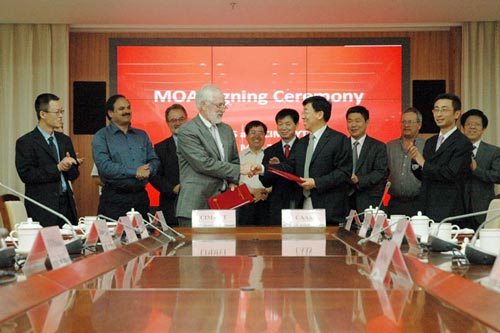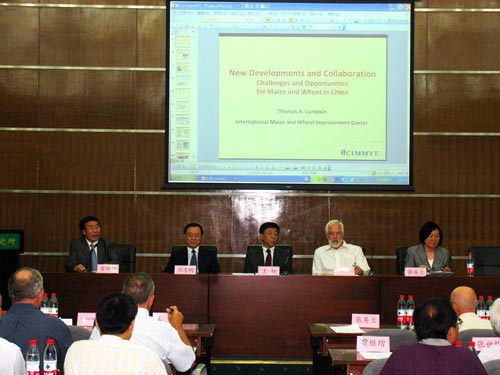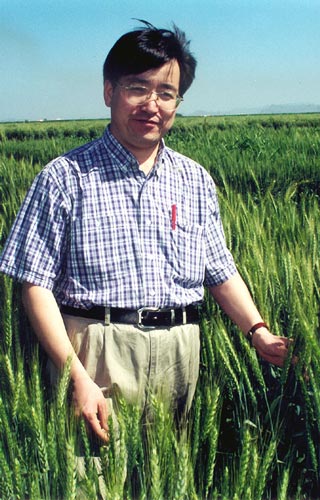CIMMYT director general Tom Lumpkin, Global Wheat Program director Hans Braun, and Global Maize Program director B M Prasanna visited the Chinese Academy of Agricultural Science (CAAS) during 16-18 May 2012. As part of the visit, CAAS President Li Jiayang highlighted CIMMYT’s contributions to Chinese agricultural development and named CIMMYT as a CAAS strategic partner for international collaboration. An agreement was also signed between CAAS and CIMMYT to further promote collaboration on applied biotechnology in crop improvement. A workshop was held on 18 May 2012 to celebrate the 30-year China-CIMMYT collaboration. There were more than 60 participants, including Ren Wang, CAAS vice president, deputy director general Liu Zhiming from the Ministry of Science and Technology, and division director Yinglan Zhang from the National Natural Science Foundation of China. Lumpkin described CIMMYT’s new development and collaboration role with China, followed by presentations from CIMMYT liaison officer Zhonghu He and five partners from CAAS and from the provinces of Sichuan, Yunnan, Shandong, and Ningxia.
 As indicated in Ren Wang’s speech, CIMMYT has the largest investment in China among CGIAR centers. Five collaborative research programs led by CIMMYT scientists stationed in China have been established at CAAS, Yunnan and Sichuan. This has created a new model for CGIAR-China collaboration and increased CIMMYT’s impact in China. CIMMYT is also the first international center to establish collaborative projects with the National Natural Science Foundation of China.
As indicated in Ren Wang’s speech, CIMMYT has the largest investment in China among CGIAR centers. Five collaborative research programs led by CIMMYT scientists stationed in China have been established at CAAS, Yunnan and Sichuan. This has created a new model for CGIAR-China collaboration and increased CIMMYT’s impact in China. CIMMYT is also the first international center to establish collaborative projects with the National Natural Science Foundation of China.
CIMMYT wheat germplasm has contributed significantly to wheat production in China. More than 90,000 wheat accessions were introduced to China and 14,000 genotypes were stored in national and provincial genebanks, accounting for around 55% of introduced wheat germplasm in China. More than 260 improved varieties were released from CIMMYT germplasm, and the accumulated planting area for these varieties has reached 45 million hectares.
More than 1,000 tropical inbred lines and populations from CIMMYT were introduced to China. CIMMYT germplasm has played a significant role in subtropical maize breeding in Yunnan, Guangxi, Guizhou, and Sichuan provinces. CIMMYT tropical maize germplasm has also been used as a donor for breeding temperate maize in northern China, as occurred in the two leading temperate hybrids Nongda 108 and Zhengdan 958.
CIMMYT-China collaborations have also had an impact on the application of molecular technology. Forty functional markers were developed, validated, and used in various wheat breeding programs, and three advanced lines developed from molecular markers are expected to be released in the next few years. These markers have been widely used to characterize Chinese and CIMMYT germplasm. A novel method for mapping quantitative trait genes, the ICIM, was developed and used in many countries. Breeding simulation tools are used to optimize the complicated breeding strategies. Nine training courses have been held in China, Mexico, IRRI, and Australia to promote new tools and methods. QTL analysis through joint linkage-LD mapping was developed and used to understand molecular mechanisms for drought tolerance. The genes related to the biosynthesis of proV A have been cloned and used to develop functional markers for molecular breeding. Chip-based and sequencing-based genotyping techniques have been used for genetic diversity analysis, haplotype map construction, and association mapping in maize. More than 400 papers have been published in peer-reviewed journals, including several papers in high-impact journals such as Genetics (2007), PNAS (2010), and Nature Genetics (2010, 2012).
 Bed planting has produced significant impact in the provinces of Gansu, Ningxia, Sichuan, Shandong, and Henan, bringing among other benefits a 30% reduction in input use. Bed planting is particularly advantageous at saving water. Conservation agriculture techniques combined with new winter wheat varieties have been broadly extended in traditional spring wheat areas, allowing farmers to take advantage of climate change to increase yields and reduce input use.
Bed planting has produced significant impact in the provinces of Gansu, Ningxia, Sichuan, Shandong, and Henan, bringing among other benefits a 30% reduction in input use. Bed planting is particularly advantageous at saving water. Conservation agriculture techniques combined with new winter wheat varieties have been broadly extended in traditional spring wheat areas, allowing farmers to take advantage of climate change to increase yields and reduce input use.
CIMMYT trained scientists play a leading role in China. Over 800 Chinese scientists and administrators have visited CIMMYT and more than 200 scientists have participated in various training courses or visiting scientist programs and more than 60 postgraduates were trained. Among them, more than 60 serve at a research professor level or became presidents of provincial academies or directors of research institutes. As of 2012, more than 20 training courses and international conferences have been jointly organized, with more than 3,500 participants.
 Capacity development
Capacity development 